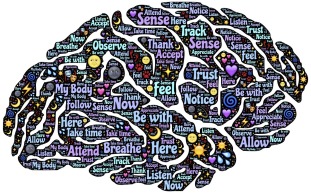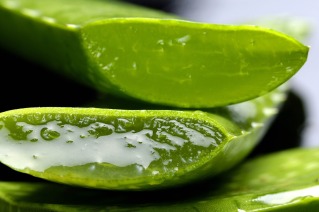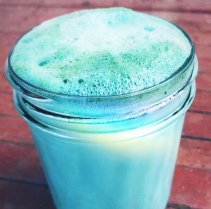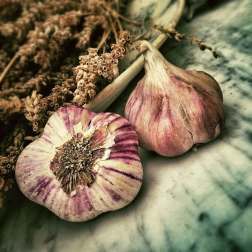
Even though (thanks to my wonderful parents) I’ve been eating organic ever since I was a baby, I didn’t truly know what that meant until I became an adult.
I knew it was better for our bodies, but I didn’t really know why. I just assumed it was because the produce was higher quality…..
While many people argue that the term “organic” is a marketing scheme or little more than just a buzzword, the science tells us that’s just not the case.
The main case for eating organic is, of course, the pesticides & herbicides commonly used in conventional farming.
When a plant is sprayed with pesticides, that plant then becomes deadly to insects. This includes pollinators, such as bees, who play a crucial role in the health of our ecosystem.
Even more unfortunately, these pesticides don’t just stick to the plant they’re sprayed on….
Pesticide run-off contaminates clean water sources that precious (and even endangered) species of wildlife inhabit, cross barriers into neighboring organic farms, evaporate into the air and cause respiratory and digestive issues in sensitive individuals, decimates soil bacteria and quality for future farming and kills our already suffering population of honeybees.
Herbicides on the other hand, kill weeds and unwanted plant growth.
The most commonly used form of herbicide in the United States is called glyphosate.
What is glyphosate exactly?
“Glyphosate is the active ingredient in the herbicide Roundup. It is a broad-spectrum herbicide, considered to be nearly nontoxic to humans (Williams et al., 2000). However, a recent paper (Samsel & Seneff, 2013), argued that glyphosate may be a key contributor to the obesity epidemic and the autism epidemic in the United States, as well as to several other diseases and conditions, such as Alzheimer’s disease, Parkinson’s disease, infertility, depression, and cancer. ” – This Study on the link between glyphosate and celiacs disease.
As a resident of Sonoma County in Northern California, I will say that during summer months when glyphosate use is most prevalent (as well as yard work such as lawn-mowing that disperses the molecules into our atmosphere) I have an increasing tendency towards digestive issues, brain-fog and headaches.
The same study cited above states that: “Fish exposed to glyphosate develop digestive problems that are reminiscent of celiac disease. Celiac disease is associated with imbalances in gut bacteria that can be fully explained by the known effects of glyphosate on gut bacteria.”
I could cite hundreds of studies on the adverse effects glyphosate has on the body – and I will probably list a few more pretty soon.
So, glyphosate is designed to kill plants… but it’s still used in farming?
Yep! This is because in 1996, a company called Monsanto (also responsible for the pioneering of glyphosate as an herbicide) released its own breed of genetically engineered plants called “Roundup Ready Crops”. They started with soy beans, followed shortly by corn and cotton.
These seeds had their DNA altered so they could withstand glyphosate, while it killed the other surrounding unwanted plants.
Whether you’re pro-GMOs or not, the evidence is clear that there is a significant amount of seed contamination between Roundup Ready seeds and Non-Roundup Ready seeds.
For example, there have been multiple cases of Roundup Ready crops appearing randomly in the fields of non-GMO farms.
Regardless of opinion, I think most people would agree that the public should at least have a choice as to whether they’re consuming GMOs or not.
But this crop contamination isn’t the only way that glyphosate affects farming.
“This system is altering the whole soil biology. We are seeing differences in bacteria in plant roots and changes in nutrient availability. Glyphosate is very systemic in the plant and is being released through the roots into the soil. Many studies show that glyphosate can have toxic effects on microorganisms and can stimulate them to germinate spores and colonize root systems. Other researchers are showing that glyphosate can immobilize manganese, an essential plant micronutrient.” – Microbiologist Robert Kremer for The Organic and Non-GMO Report.
Along with permanently altering the microbiome beneath the plant, glyphosate also alters the plants themselves.
What happens when the chemicals introduced into our ecosystem start to actually genetically alter the affected plants?
I don’t want to know.
Luckily, the Organic Certification is there for those of us who wish to avoid pesticides.
While buying organic can certainly limit one’s pesticide consumption, the line between conventional and organic is growing thinner and thinner.
This is especially true for certain mass-cultivated organic crops (I’ll be using grains as an example, but this issue is also prevalent in other agricultural sectors such as the grape and wine industry) where glyphosate has been found on the harvested plants.
And I’m not talking small amounts of residue.
According to Health Impact News, “… Tropical Traditions tested the USDA certified organic grains from suppliers they had been using, sourced mainly from western states such as Montana and Idaho. Sadly, the presence of glyphosate residue was found in organic wheat and other organic grains, including organic barley, oats, spelt, and einkorn. The range was from 0.03 to 0.06 mg/kg, just slightly lower than the conventional grains that were tested.”
Could this explain the sudden increase in individuals with “Gluten Intolerance”?
What I can say is, I’ve heard (time and time again) stories of how an individual with a gluten intolerance went on vacation to Italy, ate a bowl of wheat pasta or bread, and felt fine.
This might be because Italy, along with several other countries, has put strict regulations on the use of pesticides and herbicides in farming.
And for good reason.
When I found the following two graphs in an article written by two independent scientists (Anthony Samsel and Stephanie Seneff) I was shocked to say the least.
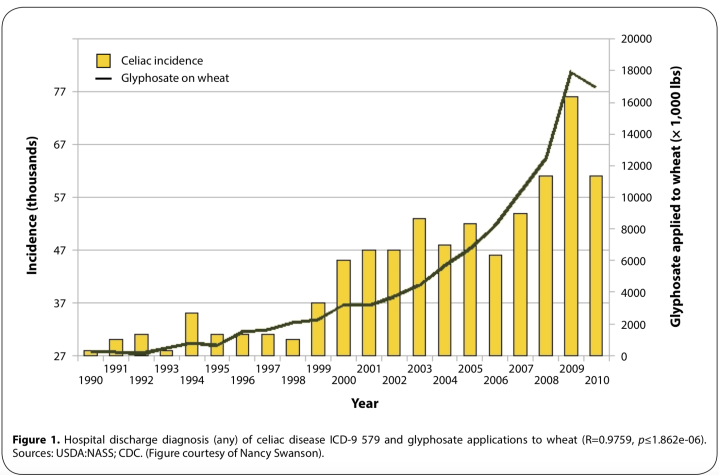

I’m sure you’ve heard this before, but everything starts in the gut.
When we take an already extremely sensitive microbiome such as our gut, then add chemicals like glyphosate into the mix, we end up with digestive tragedy.
“Glyphosate, patented as an antimicrobial (Monsanto Technology LLC, 2010), has been shown to disrupt gut bacteria in animals, preferentially killing beneficial forms and causing an overgrowth of pathogens.” – Samsel & Seneth.
Glyphosate wrecks healthy gut flora, permeates the intestinal barrier thus causing severe food allergies, and can cause liver disease at levels far under what the U.S. permits as “safe”.
A recent study where rats were exposed to low levels of glyphosate over a substantial period of time suggests that this toxic chemical has an ill effect on liver function – even in very small doses.
“… a 2-year study was conducted where rats were administered with a Roundup GBH via drinking water at a concentration of 0.1 ppb (0.05 μg/L glyphosate; daily intake 4 ng/kg bw/day), which is an admissible concentration within the European Union (0.1 μg/L) and USA (700 μg/L). The results showed that Roundup caused an increased incidence in signs of anatomical pathologies, as well as changes in urine and blood biochemical parameters suggestive of liver and kidney functional insufficiency.”
Ok, so clearly there’s some controversy around the safety of this toxic herbicide.
I want to end this article with some actionable tips for keeping pesticides and herbicides out of your body!
- Eat Organic – This is the most obvious but also the most accessible way to avoid pesticides ending up on your plate. While organic doesn’t necessarily guarantee zero pesticides, it’s a much safer bet than buying conventional.
- Find Pesticide-Tested Products – More and more companies are waking up to the threat that pesticide use imposes on organic farming. Many organic companies are now actually testing their products for glyphosate residue. This is especially important to look for when buying grains and alcohol, where cross-contamination is most prevalent.
- Buy Your Pasta From Italy – This is a great option for those buying on a budget. Since wheat grown in Italy is likely to have far less glyphosate than wheat grown in the U.S.A., buying even conventional pasta that’s imported from Italy could be safer than buying pasta that’s made in America. (This applies to wine, olive oil and tomato sauce too!)
- Keep Up With the Dirty Dozen – Every year, a list is released with the top twelve fruits and vegetables that are grown using the most pesticides. Respectively there’s also a clean fifteen list with the top fifteen fruits and vegetables that are less likely to be grown with high quantities of pesticides. This is a super helpful tool for those buying on a budget. (I would love to write a separate post about buying organic on a budget soon!)
- Buy Locally – While produce grown in areas where pesticide use is particularly high, buying locally is still always a good idea. Here in Sonoma County, we’re actually living in a glyphosate “Red Zone”, meaning there’s an extremely high amount of glyphosate use in our area. However, small, local organic farmers are likely to care immensely about how their crops are grown. Furthermore, locally grown produce is fresher and higher in nutrients, so the benefits outweigh the negatives – in my opinion.
- Grow Your Own – This is probably the most effective way to avoid pesticides. When you have complete control over your plants, how they’re grown and even what type of soil is used, there is little room for cross-contamination. Plus, it forces you to eat seasonally and generally tends to be a lot cheaper than shopping at the farmer’s market.
- Take Supplements – While this is certainly an investment, I believe that your health is well worth it. Supplements such as Restore, Spirulina and Chlorella are all wonderfully supportive to our microbiome and help to keep the ill effects of pesticides at bay.
So there you have it! There are tons of great ways to keep pesticides off your plate.
Bottom line, there’s plenty of evidence out there supporting the idea that pesticides are wildly detrimental to the health of our bodies… and the planet.
Hopefully, we will get this toxic chemical out of our food system with strict regulations and widespread education!
Peace & Healing,
xoxo – Mackenna


